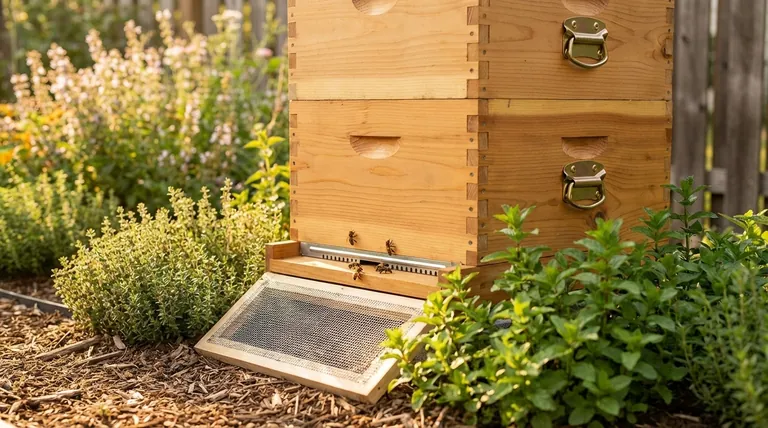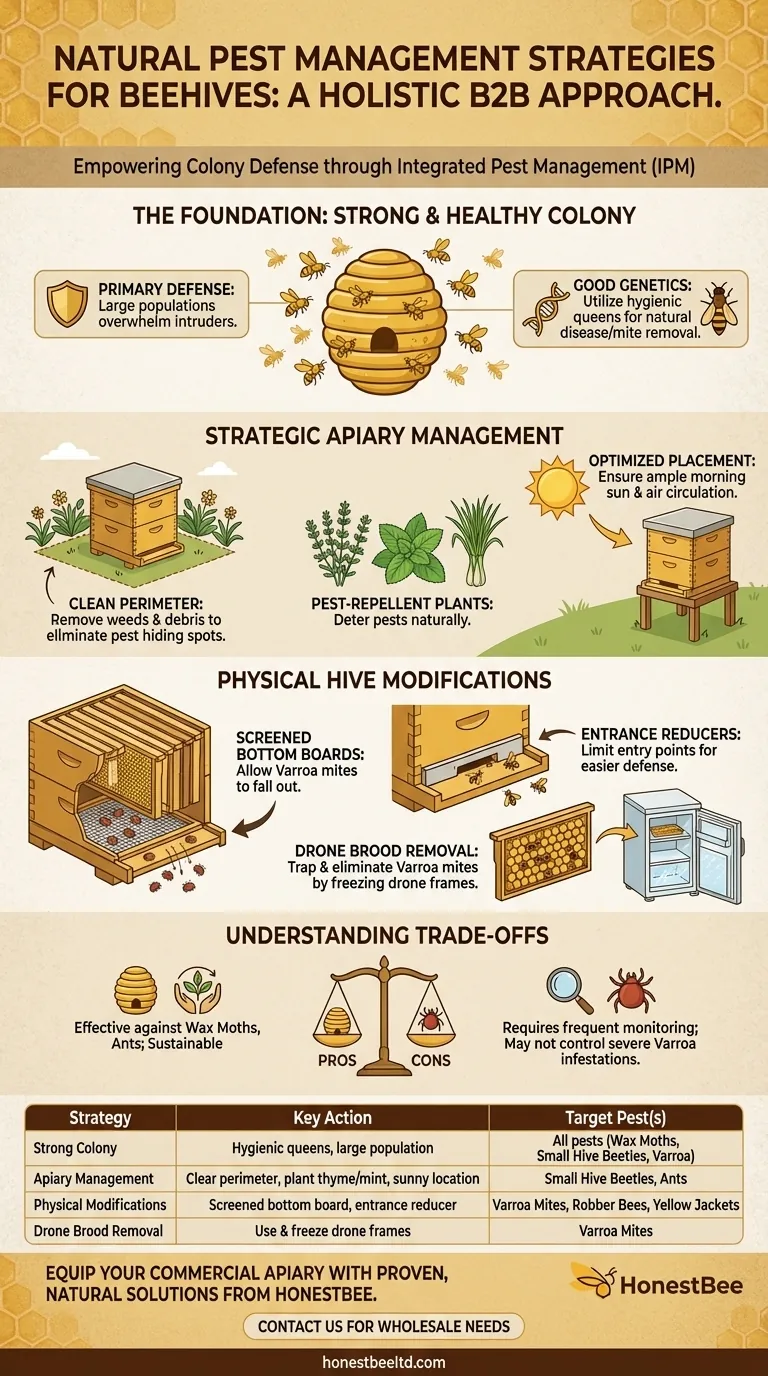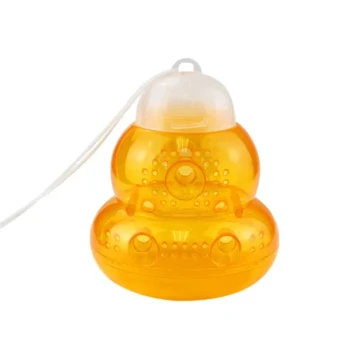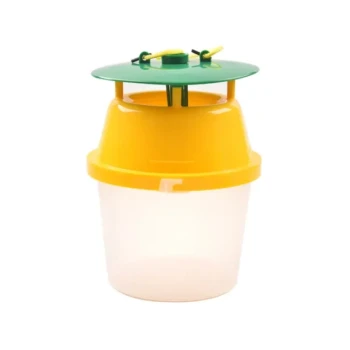Natural pest management in beehives focuses on creating an environment that empowers the colony to defend itself. Key strategies include maintaining a clean and clear perimeter around the hive, removing weeds that harbor pests, and strategically using pest-repellent plants like thyme.
The most effective natural pest management is not a single action, but a holistic approach called Integrated Pest Management (IPM). This strategy prioritizes a strong, healthy colony as the primary defense, supported by proactive environmental and physical controls.

The Foundation: A Strong and Healthy Colony
A robust bee colony is the single most important factor in natural pest defense. Pests and diseases are often symptoms of an underlying weakness in the hive.
Why Colony Strength is Key
A large, populous colony has more bees to perform defensive tasks. They can effectively guard the entrance, remove debris, and overwhelm intruders like wax moths or small hive beetles before they can establish themselves.
The Role of Good Genetics
Starting with queens from resilient, hygienic genetic stock is a powerful preventative measure. Hygienic bees are more likely to detect and remove diseased or mite-infested brood, naturally breaking the pests' life cycles.
Strategic Apiary Management and Placement
The environment surrounding your hives plays a critical role in preventing pest pressure. Simple landscaping and placement choices can make a significant difference.
Maintaining a Clean Hive Perimeter
Pests like small hive beetles and ants thrive in the shelter of tall grass and weeds. Regularly clearing the area directly around your hives removes their hiding spots. Placing hives on stands also makes it harder for crawling pests to gain access.
Utilizing Pest-Repellent Plants
Some plants contain essential oils that naturally deter pests. Planting species like thyme, creeping jenny, mint, or lemongrass around the apiary can create a less inviting environment for unwanted visitors.
Optimizing Hive Placement
Place your hives in a location that receives ample morning sun. This helps dry up dew and moisture, which discourages mold and Small Hive Beetles. Good air circulation is equally important for maintaining a dry, healthy internal hive environment.
Physical Hive Modifications for Pest Control
Simple, non-chemical additions to the hive itself can be incredibly effective at managing specific pests, particularly the destructive Varroa mite.
The Power of Screened Bottom Boards
Replacing the solid bottom of your hive with a screened one is a cornerstone of natural mite control. As Varroa mites occasionally fall off their bee hosts, they drop through the screen and out of the hive, unable to climb back in.
Reducing Entrances to Deter Intruders
A large, undefended entrance is an open invitation for pests like yellow jackets and for robber bees from other colonies. Using an entrance reducer, especially for smaller or weaker colonies, limits the area the guard bees must defend.
Drone Brood Removal for Mite Control
Varroa mites show a strong preference for reproducing in drone brood cells. You can exploit this by placing a special drone frame in the hive. Once the drone cells are capped, remove the frame and freeze it to kill the mites trapped inside.
Understanding the Trade-offs
Natural pest management is an active process, not a passive one. It requires diligence and a clear understanding of its limitations.
Efficacy Varies by Pest
Natural methods are often very effective for managing pests like wax moths and ants in a strong hive. However, they may not be sufficient to control a severe Varroa mite infestation, which remains the single greatest threat to honey bee health.
Increased Labor and Monitoring
Unlike "set-and-forget" chemical treatments, natural methods require more frequent monitoring and intervention. You must be prepared to conduct regular hive inspections to assess colony health and pest levels, and to act when necessary.
Making the Right Choice for Your Apiary
Your approach should be tailored to your specific goals, local pest pressures, and the amount of time you can dedicate to your bees.
- If you are a new beekeeper: Focus on the fundamentals—start with strong bees, use a screened bottom board, and maintain a clean, sunny apiary location.
- If your primary concern is Varroa mites: Combine a screened bottom board with drone brood removal and be prepared to learn other methods like powdered sugar dusting if mite counts rise.
- If you struggle with Small Hive Beetles: Ensure your colony is strong and not in a hive that is too large for them to patrol, and consider adding physical beetle traps inside the hive.
By focusing on building a resilient apiary, you create a true partnership with your bees, empowering them to thrive.
Summary Table:
| Strategy | Key Action | Target Pest(s) |
|---|---|---|
| Strong Colony Foundation | Use hygienic queens; ensure large, populous hive. | All pests (Wax Moths, Small Hive Beetles, Varroa) |
| Apiary Management | Clear perimeter; plant thyme/mint; ensure sunny location. | Small Hive Beetles, Ants |
| Physical Hive Modifications | Install screened bottom board; use entrance reducer. | Varroa Mites, Robber Bees, Yellow Jackets |
| Drone Brood Removal | Use & freeze dedicated drone frames. | Varroa Mites |
Equip Your Commercial Apiary with Proven, Natural Solutions from HONESTBEE
Building a resilient apiary starts with the right equipment and strategies. HONESTBEE supplies the essential tools for effective Integrated Pest Management (IPM), including durable screened bottom boards, entrance reducers, and more. Our wholesale-focused operations are designed to support commercial beekeepers and distributors in managing pest pressures naturally and sustainably.
Let's strengthen your operation. Contact our team today to discuss your wholesale needs and build a healthier, more productive apiary together.
Visual Guide

Related Products
- Professional Grade Foldable Beehive Handles
- Wooden Bee Brush with Triple Row Artificial Fiber for Beekeeping
- Stainless Steel Honey Bee Smoker Hive and Honeycomb Smoker for Beekeeping
- Black Plastic Beetle Barn Hive Beetle Trap for Beehives
- Professional Pneumatic Wire Embedder for Beehive Frames
People Also Ask
- What are some potential benefits of drones in a bee colony? Enhancing Hive Health and Productivity
- Why is it important to understand honey bee behavior when handling them? Master Safe & Effective Beekeeping
- Why are regular hive checks important for Flow Hives? It's About Bee Health, Not Just Honey
- When should the first inspection of a new hive be conducted? Ensure a Strong Start for Your Colony
- What equipment is needed to start beekeeping? Your Essential Guide to a Successful Apiary



















